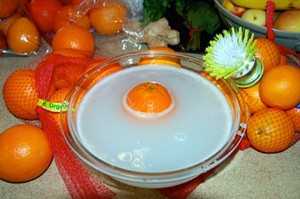
Ah… that Suzanne and her place near the river. Leonard Cohen’s first great song still haunts the airwaves, expanding our notion of the exotic, still seducing us with the bittersweet taste of what we want to be but aren’t, through those oranges.
Do you ever have food cravings? Mine, this week, was for oranges. It’s partly that we all probably do need the Vitamin C and trace minerals found in oranges, at this time of the year, but food cravings connect to all sorts of things, and it may be too that I was remembering China, where I spent last winter.
In North China as well as North America, January is orange season. Kumquats, clementines, tangelos, oranges, pomelos like soccer balls, satsumas, and mandarins–every orange you can imagine appears on the streets of Beijing suburbs in January. Trucks, vans, bung-bung taxis and bicycle carts trundle up and down the streets laden with crates and sacks bulging with ripe citrus. Fruit vendors pile them up. Boxes of clementines and baby mandarins flow out the doorways of the fruit shops onto the sidewalks; itinerant vendors and truckers set up displays on the street; supermarkets stack oranges in seven-foot pyramids. At home, people put out little kumquats, with walnuts, to eat whole, skins and all. “Very good for you!” our friends insisted. “Not get colds.”
In Canada too, we eat oranges in the winter for the Vitamin C, though I wonder if it’s as much for the idea that oranges will chase away colds and

flu. The average orange has 65 –95 gms. of Vitamin C—not a lot, but more than the recommended daily requirement 75-90 for women and men respectively, according to Health Canada. But it’s the colour as well as tang of a sweet-sour orange or tangerine, the glow of a mandarin, that remind us that the sun is still up there, even when we can’t see or feel its warmth.
Obtaining organic oranges is a challenge—of all the varieties sold in Revelstoke (grapefruit, pomelo, pink navals, clementine, mandarin, large naval, small naval, tangelo, lemon, lime and key limes) I found, only one that’s organic, at PT Market. A 2002 study of organic versus regular oranges suggested that organics may have 30% more Vitamin C than regular oranges, so we can hope they’ll become more available.

Also, organic oranges may have less of the wax or resin used to coat oranges “to preserve freshness,” as the label on the bag read. Even the organic oranges appear to be wax-coated, making me wary of using too much orange zest—the outer skin—as flavouring. I tried to wash the wax away with a product called FIT. The FIT treatment was more effective than either plain hot water and detergent, or vinegar, both of which I tried. You certainly need to scrub the orange peel well, and rinse it thoroughly, before zesting.
The flavour boost from oranges matches the psychology, however conditioned by the orange marketing people it may be. You feel that an orange is good for you—just as Suzanne’s oranges came close to symbolizing a prayer. Here are some recipes that use oranges, and some other winter veggies in strong supply just now.



